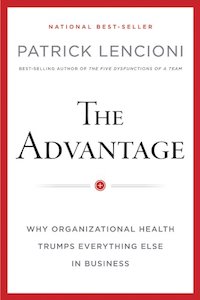To lead and manage teams effectively the My Org App has leveraged the top principles and action items that came from the most trusted resources. The list below has the details on this book and all the key principles and actions that came from this book to make the app.
Resource Details:
Principles summarized

A “healthy” organization is the one with high morale, low turnover, minimal politics, and high productivity. In other words, “health” has to do with the management of people, unlike “smarts”, which Lencioni describes as organizations having effective strategy, marketing, finance, and technology.

If everything is important, nothing is!The organization must have one single top priority within a given period if it wants to have a sense of alignment and focus between employees and not have them pulled in a different often conflicting directons.Anything more than one top priority creates a potential for disagreement and misalignment (think of firefighters in a burning building, or ER persononnel - they are always aligned because they always have a clear priority).
Guides leveraged

A simple description of what an organization actually does. No flowery adjectives or adverbs here. Nothing ethereal or abstract. Just an unsexy, one-sentence definition—something your grandmother can understand.

The point here is that every organization, if it wants to create a sense of alignment and focus, must have a single top priority within a given period of time.

The purpose of the thematic goal is to provide the leadership team a clarity around how to spend its time, energy and resources in the next 3 to 12 months.The benefits of establishing a single overarching top priority for this period - the thematic goal - are enormous. Divisional rivalry and infighting become much less likely as leaders stop seeing their primary responsibility as solely running their own departments.

Defining objectives are the general categories of activity required to achieve the thematic goal. Like the thematic goal, defining objectives must be qualitative, temporary, and shared by the leadership team. They provide a level of specificity so that the thematic goal isn’t merely a slogan but rather a specific and understandable call to action. In most cases, there are between four and six defining objectives, depending on the nature of the goal itself.

Strategy is simply a collection of intentional decisions an organization makes to give itself the best chance to thrive and differentiate from competitors.Strategic anchors are identified as a way to provide the context for all decisions to be made. They inform and provide filter through which all decisions can be evaluated to ensure consistency.The strategic anchors also help avoid making purely pragmatic or opportunistic decisions that end diminishing company's plan for success. It's way for an organization to agree on what NOT to do. The strategic anchors should change as soon as competitive landscape changes and market conditions call for a different approach. Unlike a company’s reason for existing and core values, which never change, and the business definition, which changes fairly infrequently, an organization’s strategic anchors should change whenever its competitive landscape shifts and market conditions call for a different approach.

The purpose of the standard operating procedures is to provide the ongoing and relatively straightforward metrics and areas of responsibility that any leadership team must maintain in order to keep the organization afloat... Coming up with standard operating objectives is not terribly difficult because they are usually somewhat obvious. In for-profit companies, they usually include categories like revenue, expenses, customer retention or satisfaction, product quality, cash flow, morale, or any other issues specific to a given industry. In a hotel, it would certainly include room occupancy, in a school it would include graduation rates and test scores, and in a church it might well include attendance and financial giving... Every company will have a slightly different set of standard objectives that it tracks, but it will be relatively predictable and consistent depending on the industry and it won’t change much over time

These are the minimum behavioral standards that are required in the organization. Although they are extremely important they don't serve to clearly define or differentiate an organization from others. Values that commonly fit into this category include honesty, integrity, and respect for others.

You won't find accidental values framed on the boardroom wall or memorialized on the website, but employees know that they are there and their presence may mean that you are investing precious compensation funds in actively undermining your desired culture.These arise spontaneously within a team over time, without being cultivated by leadership. They can be beneficial, but can produce negative forces, even to the point of being team toxic.These values that are traits evident in the organization, but came about unintentionally and don't necessarily serve good for the organization. These values can come as the result of hiring people from a similar background over time. It's important that leaders guard against accidental values taking root as these can prevent new ideas and people from flourishing in the organization. Sometimes they even sabotage its success by shutting out new perspectives and even potential customersIn biological ecosystems, genetic diversity is one of the most important principles. Diversity in a complex system is important because the many benefits far outweigh the costs (of variation within the system). Diversity can stabilize a system and make it resilient to environmental changes. Diversity helps a system to survive in tough environments. It increases flexibility and feeds innovation.

These are the characteristics the organization wishes to have or must have in order to maximize their success. These values may change over time to allow the organization to adapt as oppose to the core values that do not change.

These are the few—just two or three—behavioral traits that are inherent in an organization. Core values lie at the heart of the organization’s identity, do not change over time, and must already exist. In other words, they cannot be contrived

